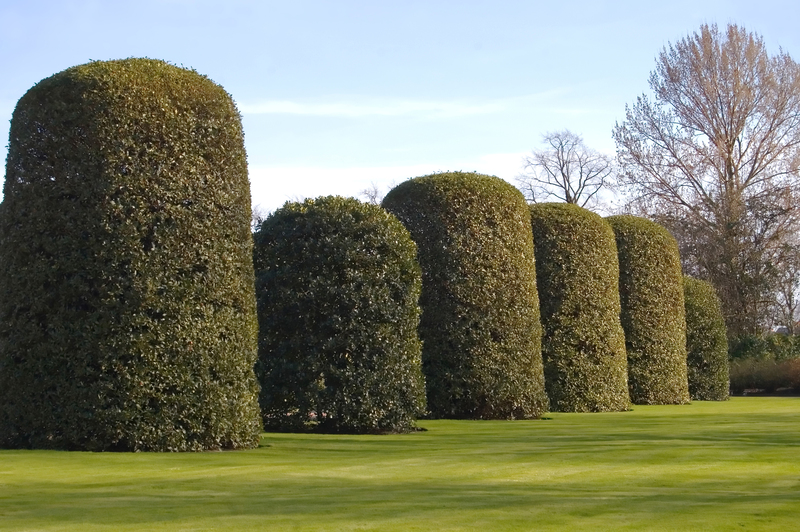Design a Zen Garden Oasis for Mindful Peace and Quiet
Posted on 04/10/2025
Design a Zen Garden Oasis for Mindful Peace and Quiet
In today's fast-paced world, stress and noise seem unending. Many people are seeking tranquil spaces to unwind, reflect, and restore their balance. Creating a Zen garden oasis cultivates an environment of mindful peace and quiet within your own home or backyard. If your goal is to enjoy the soothing benefits of nature, reduce daily anxieties, and foster personal wellbeing, designing your own Zen garden sanctuary offers a timeless solution. In this comprehensive guide, you will discover how to design a Zen garden oasis for mindful peace and quiet, merging both traditional and modern techniques to craft your personal haven.

Understanding the Essence of a Zen Garden Sanctuary
Before diving into the practical steps, it's essential to comprehend what makes a Zen garden truly special. Originating from Japan, Zen gardens, or karesansui, are dry landscape gardens designed for contemplation and meditation. The philosophy behind Zen gardens emphasizes simplicity, harmony, and the mindful arrangement of natural elements. Unlike typical Western gardens, these serene spaces are not filled with a multitude of colorful flowers or ornate ornaments. Instead, every stone, plant, and ripple in the sand carries meaning, encouraging quiet introspection and a connection with nature.
- Minimalism: Use fewer elements to inspire calm and clarity.
- Symbolism: Each feature (such as rocks, sand, and moss) holds deeper significance.
- Balance and Harmony: Strategic placement evokes unity and tranquility.
Why Create a Zen Garden for Peace and Quiet?
Designing a Zen garden for mindful peace isn't simply about aesthetics--it supports mental wellness and emotional balance.
- Encourages meditation and mindfulness practices
- Reduces stress and fosters relaxation
- Improves focus and mental clarity
- Provides a peaceful retreat from daily life
Let's explore how to bring these benefits into your own surroundings, whether you have a sprawling backyard or a small balcony.
Step-by-Step Guide: How to Design a Zen Garden Oasis
1. Choose the Perfect Location for Serenity
Your Zen oasis should occupy a space where disturbances are minimized. Consider the following when selecting your garden's placement:
- Privacy: Ideally, choose a secluded area away from street noise and distractions.
- Accessibility: Ensure it's close enough for daily use, but far enough to create a sense of retreat.
- Natural Light: Balance between shade and sunlight according to your climate and plant preferences.
2. Embrace Zen Garden Planning Principles
At the heart of every mindful Zen retreat lies structure and purpose. Here are key design aspects:
- *Asymmetry*: Unlike Western gardens, Zen spaces rarely use perfect symmetry. Asymmetrical layouts foster balance and intrigue.
- *Simplicity*: Prioritize fewer, meaningful features. Every stone, plant, and structure should have a clear reason for its place.
- *Naturalness (Shizen)*: Avoid artificial lines. Emulate organic shapes and forms.
- *Enclosure (Miegakure)*: Use fencing, walls, or hedges to subtly shield the space, helping create an intimate setting.
- *Space (Ma)*: Leave open areas to represent water, sky, or thoughts--essential for mindfulness and peace.
3. Select the Right Elements for Your Zen Oasis
Designing a peaceful Zen garden oasis means incorporating elements carefully, each with its own symbolic weight. The following are essential traditional components:
- Rocks and Stones: The backbone of any Zen garden, symbolizing mountains, islands, or animals. Arrange in odd numbers, using various shapes and sizes, and often position upright.
- Gravel or Sand: Represents water or fluidity; raked in patterns to evoke ripples or waves. Sand or fine gravel is the foundation of most dry Zen landscapes.
- Moss: Softens harsh stone edges and represents age and serenity. Thrive in moist, shady spots.
- Bamboo or Wood: Employ bamboo fences or wooden bridges for enclosure and movement.
- Lanterns or Stone Sculptures: Understated sculptures provide subtle focal points, encouraging contemplation, but should never dominate the garden.
- Water Elements: Although not essential, a simple water basin, bubbling fountain, or pond offers auditory tranquility, invoking peace and calmness.
4. Add Mindful Plantings
Unlike gardens brimming with color, a Zen oasis focuses on shades of green with rare, subtle highlights. Plants evoke seasons and resilience, and their shapes reinforce harmony. Suitable options include:
- Bamboo: Symbolizes strength and flexibility; ideal for natural fences.
- Japanese maple: Provides color changes throughout the year; its delicate leaves add elegance.
- Pine trees: Represent longevity and steadfastness.
- Moss and groundcovers: Heighten serenity and require little maintenance.
- Azaleas or camellias: Offer discreet pops of color, reflecting the beauty of transience.
Carefully curate each plant to ensure minimalism and easy maintenance. Remember, a Zen garden is not about abundance but about intentional presence.
5. Integrate Paths and Stepping Stones for Contemplation
Paths guide visitors through your Zen retreat garden, encouraging slow, deliberate movement. Use natural stone or wooden planks for a grounding effect. Stepping stones should be laid in irregular patterns, promoting mindful walking and appreciation of one's surroundings. Avoid straight or overly formal paths; instead, create gentle curves offering mystery and subtle discovery.
6. Create Calming Spaces to Sit and Reflect
No Zen garden oasis is complete without a dedicated spot for relaxation and meditation. Incorporate:
- A stone or wooden bench: Offers a place to pause and absorb the scenery.
- A deck or platform: For yoga, stretching, or silent contemplation.
- Simple cushions: Allow you to sit comfortably for longer meditative practices.
Place these features discreetly, blending them into the landscape while providing optimal views of the garden's most tranquil scenes.
7. Enrich with Subtle Details: Accessories for Mindful Quiet
Final touches matter. Enhance your Zen garden design for peace and quiet with:
- Wind chimes or bells: Invite gentle, soothing sounds that add to the ambiance.
- Minimal lighting: Use soft, hidden lights to illuminate paths or feature trees at night, extending the garden's serenity after sunset.
- Incense or candle holders: Encourage mindful rituals and scent-based relaxation.
*Less is more.* Each accessory should serve a meaningful purpose and not distract from the overall meditation experience.
Maintaining a Zen Garden for Continuous Mindful Peace
Unlike high-maintenance traditional gardens, your Zen garden for mindful peace and quiet is designed for longevity and ease. Keep these upkeep tips in mind:
- Rake sand or gravel regularly, refreshing patterns--this practice itself is meditative.
- Trim plants and moss gently, preserving their natural forms.
- Remove fallen leaves and debris to maintain uncluttered simplicity.
- Inspect stone and wooden elements for weathering, addressing repairs as needed.
Consider integrating a simple daily ritual--such as five minutes of sand raking or silent sitting--to reinforce the space as your quiet retreat and keep your mind attuned to the present moment.
Modern Zen Garden Variations for Urban Spaces
If you lack abundant outdoor space, you can still create a Zen garden oasis for peace and mindful quiet indoors or on a balcony. Key tips:
- Downsize: Use tabletop Zen gardens, featuring miniature rocks, rakes, and tiny plants.
- Container gardening: Pick elegant pots for bamboo, moss, or small shrubs.
- Incorporate water: Add a desktop fountain for gentle, calming sounds.
- Use vertical features: Hanging moss, wall art, or bamboo screens impart privacy and nature, even in -small spaces-.
- Maximize natural light and fresh air where possible.
Even a small corner, thoughtfully arranged, provides an immediate sanctuary for mindful peace.
Indoor Zen Oasis: Tips for Peace and Mindfulness at Home
- Dedicate a quiet corner with a simple sand tray, a few stones, and a single figurine or plant.
- Use natural materials--such as linen, burlap, or wood--for mats or cushions.
- Incorporate calming scents like sandalwood, cedar, or green tea to enhance meditation.
- Designate the area as a screen-free, distraction-free zone for maximum peace and quiet.
Mindful Meditation Practices in Your Zen Garden Sanctuary
Once your Zen garden for mindful peace is complete, it's time to embrace mindful routines. Try:
- Walking meditations: Move slowly along the paths, focusing on your breath and surroundings.
- Sand raking: Practice repetitive, flowing movements to quiet the mind.
- Silent sitting: Observe natural sounds, shifting light, and subtle garden changes.
- Journaling: Reflect in a dedicated peaceful spot, recording thoughts and observations.
Invite others (or enjoy solo time) to reinforce the garden's role as an oasis of peace within a busy world.

Frequently Asked Questions: Creating a Peaceful Zen Oasis
How much space do I need for a Zen garden sanctuary?
You can design a Zen garden for mindfulness and quiet in areas as small as a few square feet (using tabletop versions), up to large backyards. The principles of minimalism and intentionality apply regardless of scale.
Is building a Zen garden costly?
A Zen oasis can be affordable, especially if you use locally sourced rocks, native plants, and upcycled materials. Choose simplicity and meaningful design over expensive features.
Do Zen gardens require a lot of maintenance?
No. Zen-inspired gardens are low-maintenance. Occasional raking, light pruning, and debris removal suffice, making them ideal for busy lifestyles seeking peace and quiet.
Can I add water features?
Traditional dry Zen gardens avoid real water, instead representing it symbolically. But, for personal retreats, gentle fountains or water basins are welcome, especially in modern adaptations.
Conclusion: Transform Life with a Zen Garden Oasis of Peace and Quiet
Designing a Zen garden oasis for mindful peace and quiet invites a pocket of tranquility into daily life. Through mindful arrangement of natural elements, attention to space, and the embracing of minimalism, anyone can carve out a restorative retreat. From vast landscapes to small balconies or desktops, Zen principles can help anyone seeking calm in a chaotic world.
Start with intention, nurture your garden regularly, and let it become a living practice of mindfulness and serenity. Your Zen garden oasis will not only transform your physical space, but also your mental and emotional well-being--guiding you toward a more peaceful, present, and mindful life.
- Keyword variations used: Zen garden oasis, mindful peace, peace and quiet, Zen garden for mindfulness, Zen garden sanctuary, peaceful Zen garden, Zen retreat, Zen garden design, mindful Zen retreat, Zen oasis, Zen garden for mindful peace and quiet.

